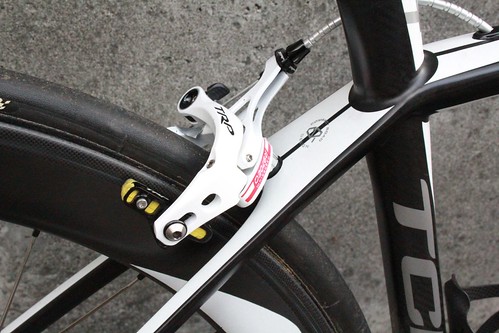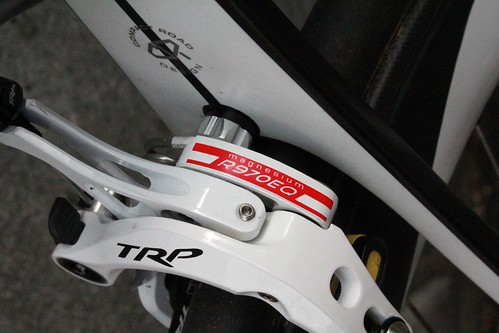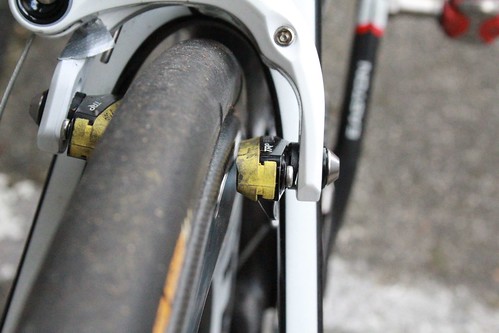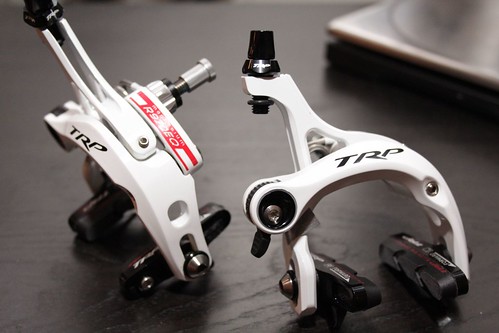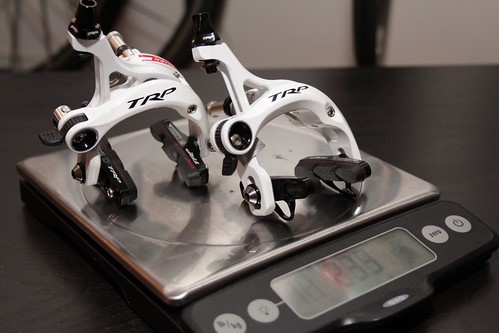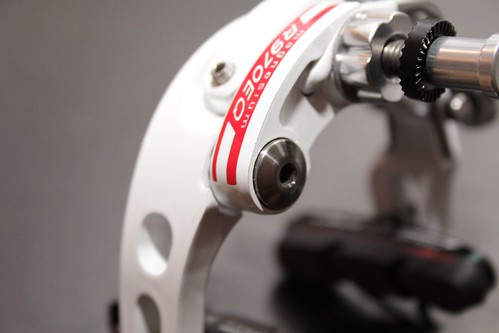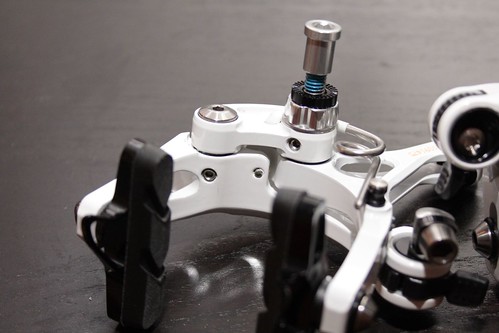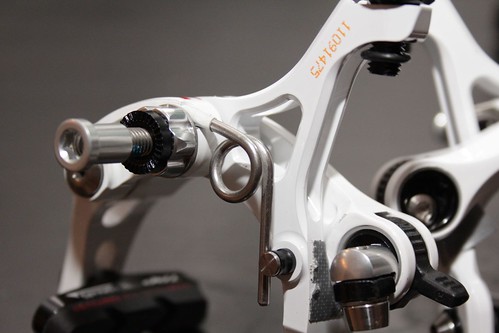I’m not usually one to chase after ultra light brakes. My biggest gripes about them is that they usually don’t stop well and their fittings, such as the fixing bolts, are fragile or don’t weather well. Mostly I’ve been happy to run stock Dura Ace or Red calipers. However, one of the newer trends in the road scene has been aero wheels with fat toroid profiles. Instead of the typical 19-20mm width at the brake track, some of these wheels are pushing 26mm+. The big manufacturers caught onto this trend just a little too slow, and as a result those stock calipers just won’t comfortably fit the latest race wheels. I tried to solve this problem by filing the arms of the rear brake on my TCR, since the the problem is worse on the back due to the friction loses of the longer cable and lateral flex inherent in dished rear wheels. But filing out metal on brake arms isn’t a very elegant solution. However, if TRP wants to make a brake that will fit a fat rim, uses quality hardware fittings, is lighter and aesthetically pleasing to boot, then I’ll break from habit and try something new: the R970EQ.
The TRP R970EQ ($600) is a development of the forged and CNC’ed magnesium R970SL caliper. Both versions have titanium hardware in a conventional dual-pivot design as well as TRP’s clever sliding quick-release barrel adjuster. The definitive difference is the EQ’s additional quick release incorporated into the brake arm, just like Red or Dura Ace (but not like Campagnolo which builds the QR into the handlebar control lever). I talked to TRP’s Lance Larrabee, who explained that the EQ was a response to a request by professional teams such Geox-TMC for a conventional quick release. The pro riders like to use a regular quick release to open up the rear caliper on the ascents of mountain stages so that the rear rim won’t rub and then close the brake’s QR for the descents. The sliding quick release makes the brake inoperable when open, so TRP added the cam-style quick release that can be easily operated while riding. Indeed, I found the new quick release easy to use, very smooth. However, the quick release should only be used in a full-open or full-closed position, since the cam’s ratchet isn’t designed to lock into intermediate positions.
Back to the R970EQ’s fittings, I was pleased to see the level of refinement did not lack. When I look at the backside of a $600 brake caliper, I expect to see bolts that are higher quality and a little more specific to the component than what I can pull out of bins at the local hardware store. And the fittings are appropriately sized for their uses; for instance, the cable fixing bolt takes a 5mm Allen tool rather than an all-too-easily rounded out 4mm. Less obvious to most users, the caliper’s two pivots both use thrust bearings to ensure the brake’s smooth and precise action. All these details put the R970EQ on the same level as Red, Dura Ace, and Record; that is, equipment that is meant to perform and survive in the rigours of a pro race environment.
Out of the box, the R970EQ brakes weigh 234gr/pr with pads and mounting nuts, which is about 30-40gr less than SRAM Red. Two sets of pads are included, one for carbon and one for alloy rims. I didn’t actually test with either of the stock pads since I wanted to evaluate the performance of the TRP caliper alone against my normal SRAM Red, so I used the same pads in both calipers (KoolStop for aluminium and SwisStop Yellow for carbon). I chose the white version of the R970EQ since that colour is the most distinctive against the stock calipers from the Big 3 component makers. Also, the brakes look badass with the white and carbon of this Giant TCR. The glossy finish is a little thin at the arms’ sharper edges but is otherwise even across the flatter surfaces. The black and red logos are a nice accent.
The performance of a brake caliper is mainly determined by the cable actuation ratio of the caliper relative to the control lever, the stiffness of arms, and the ability of the return spring to snap the caliper open against frictional drag at the pivots and cable/housing. TRP describes the R970EQ and R970SL as having a ratio intermediate between SRAM and newer Shimano, and I would agree. Thoeretically, this means that for a SRAM lever, the TRP brake ends up with a lot of leverage, at the expense of some modulation. Within my stable, I have Red levers connected to both Red calipers and older Dura Ace 7800; the 7800 brakes feel like they have less leverage than Red in terms of cable pull ratios. The TRP 970EQ feels like it has just a little more leverage than Red, without feeling too grabby. Switching between bikes, I hardly notice the difference in modulation between Red and the TRP product.
Combining the R970 with Dura Ace 7900 levers would have the calipers a little starved for leverage compared to the most caliper/lever likely combinations in today’s market, but the R979SL and EQ brakes are specifically optimized for new Shimano anyways.
The other crucial parameter to me is that these brakes open up enough for my Hed Stinger6 wheels, which are a husky 27.5mm at the lower boundary of the brake track. These Heds are the most girthsome of carbon wheels on the market, and the R970EQ just barely swallows them. But like a boa constrictor choking down a basketball, the calipers really are at their limit when proper clearance is achieved, since the caliper cannot physically open wider. Having the low friction RideOn brake cables is really boon in this situation, since the return spring is at its most relaxed state when the arms are opened this wide. And the TRP brakes do get the job done better then SRAM calipers with these rims. I set the R970EQ brakes up for Hed Stinger6 with the quick release open so that way I can close the cam as a way to adjust for aluminum rims (23mm wide Hed Belgium rims). That way I don’t need to make gross adjustments with the barrel adjuster. However I still need to reposition the brake pads when I have been switching between the Hed Stinger6 and the relatively skinny (~20-21mm) Enve 25 carbon tubular rim. This isn’t a fault of the brake in any way, because those rims are extreme opposites to one another, but the frequent loosening and tightening of the pad fixing hardware has caused the white paint to flake off a little bit. Perhaps the black version of the R970 would be less prone to this.
I have had these TRP brakes on my bike for a couple months now, and I like them more as time goes on. The brake feel suits me well, somewhat high leverage to give abundant power but not without proper modulation. I could see how hypothetically a heavy rider might run out of lever travel before developing maximum stopping power, particularly with wet conditions or with crappy pads, but whenever I reached for brake power it was there in spades. On a technical descent I can concentrate on my position and line, riding it closer to the edge of control, knowing that I don’t have to factor in cumulative hand fatigue from the repeated death grips necessitated by weaker brakes. During a few panic stops precipitated by imbecile drivers, the brakes delivered every bit that I asked and promised more….though they had already taken me to the limit of tire adhesion. When I run the Stinger6 wheels, I don’t get rub on the rear pads because the caliper opens wide. They are about 40gr lighter than a pair of SRAM Red calipers, but they work marginally better for me in most respects and look posh. Are they worth the extra money for those small improvements? My dear chap, if one is looking for brakes lighter than Red and that work better with state of the art carbon aero rims, one has clearly stopped normalizing performance with a monetary denominator. Still, these grabbers are probably mid-pack for cost compared to similar high-end brakes; yet mounting the R970EQ on your bike doesn’t mean accepting odd ergonomics or frail hardware.
TRP R970EQ brakes. They’re light. They fit fat rims. They stop well. They install and adjust like high-quality stock brakes from Shimano or SRAM. They look just enough different from those other calipers to be cool.
…We're riding townies, adventure, and mountain bikes. Find recommendations on our store page. As Amazon Associates we earn from qualifying purchases.

